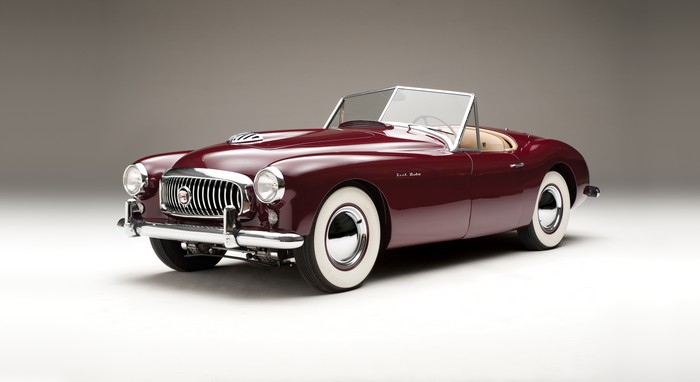What emerged from this two-year restoration process is nothing short of remarkable — Donald Healey’s own Nash-Healey, exactly as he built it, with no expense spared to ensure 100% historical accuracy. Restored by Tsikuris Classics — under the supervision by noted authority Bill Emerson. All major components are original to this car. With ownership history that begins with Donald Healey himself, there is no collection in the world, no matter how grand, that this car will not enhance.
SCM Analysis
Detailing
| Vehicle: | 1950 Nash-Healey Roadster |
| Number Produced: | 104 |
| Original List Price: | $4,063 |
| Tune Up Cost: | $175 |
| Chassis Number Location: | Right fender panel |
| Engine Number Location: | Right front of block |
| Club Info: | Nash-Healey Registry |
| Website: | http://nashhealeyregisty.com |
This car, Lot 42, sold for $500,000, including buyer’s premium, at Worldwide’s Houston Classic auction on May 4, 2013, at the La Torretta Lake Resort and Spa in Montgomery, TX.
Donald Healey was the consummate car guy. His initial interest was aviation, and he became a Royal Flying Corps pilot during World War I. His love of flying waned after friendly fire from British anti-aircraft guns shot down his plane while he was on one of the first night-bombing missions of World War I. Healey was discharged at the age of 18 because of his injuries. He took a correspondence course on automotive engineering, and at the conclusion of World War I, he opened an automotive garage.
He was an active participant in automotive events and won the 1931 Monte Carlo Rally while driving a 4½-liter Invicta. The following year, he won the unlimited sports-car class at the Brighton Speeds Trials in the Invicta and continued to participate in the Monte Carlo Rally, finishing in the top eight in 1932, 1934 and 1936.
Healey served a brief stint with Riley and then became general manager of the Triumph Motor Company and developed several successful models. After World War II, he formed the Donald Healey Motor Company Ltd. The initial cars were powered with Riley engines.
Then Healey noticed the success that Briggs Cunningham was having with the new OHV Cadillac V8 engines. He was soon on the Queen Elizabeth ocean liner for the weeklong voyage to the U.S. — and a visit to Cadillac.
From GM to Nash
There is an oft-told tale of Healey’s chance meeting with George Mason, president of Nash Motors, on the journey — which resulted in them forming a partnership. However, in fact, their agreement did not materialize until after Ed Cole at General Motors turned Healey down.
Healey’s deal with Nash was a classic win-win agreement. Mason needed to improve the image of Nash, and a sporty car in their showrooms was just the ticket. Nash, in turn, offered a U.S. outlet for Healey’s new sports car, and the Nash Ambassador 6 engine, modified with a pair of SU downdraft carburetors, had power to spare.
After a shakedown at the 1950 Mille Miglia, Healey’s modified Panelcraft aluminum-bodied Nash-Healey prototype was entered in the 24 Hours of Le Mans and finished a surprising 4th, besting Jaguar, Ferrari and the Cadillacs of Briggs Cunningham. George Mason promptly approved production.
Priced at a costly $4,063, only 104 of the Panelcraft-bodied Nash-Healeys were produced. Twenty survive today, and only seven are in operable condition. The first cars, produced in 1950, had the accelerator located between the clutch and brake, which was the configuration of the Formula One cars of the era. The paint choices were Sunset Maroon or Champagne Ivory, with Goodyear whitewalls standard.
The first U.S. sports car?
The first production Nash-Healey — number 2001 — was first shown at the Miami Auto Show in February 1951, and the results were favorable. Tom McCall, the most respected automotive journalist of the era, wrote of it in glowing terms: “Of all the sports cars I have tested — and I have driven most of them — I would just as soon own a Nash-Healey as any on the road.”
A strong argument can be made that the Nash-Healey was in fact the United States’ first production sports car. Of course, you have to overlook the Silverstone body and the assembly that took place at Healey’s Warwick factory in England. The car did, however, have a Nash drivetrain and predated the Corvette by several years. The earlier Kurtis-Kraft and the Muntz Jet were not actual production cars in the true sense of the word.
A rich, documented history
The history of chassis 2001 was thoroughly documented ever since it left Donald Healey’s ownership. It recently received a stunning two-year, $400,000 restoration and is correct to the most exacting detail.
At first glance, the price paid here was all the money and then some.
A search of SCM’s Platinum Auction Database finds a few well-restored, Pininfarina-bodied Nash-Healeys selling from $120,000 to $140,000. So, how do we justify $500k here?
Well, alloy-bodied Mercedes-Benz Gullwings sell for about three times more than their steel counterparts. RM Auctions, at their 2012 Amelia Island sale, sold a 1950 aluminum-bodied Jaguar XK 120 for $290,000.
So, if the Panelcraft-bodied Nash-Healey is worth about three times as much as the later, steel-bodied examples — and we throw in a premium for quality of restoration and the fact that this is the documented, unmolested, first-ever Nash-Healey, then we are just about there. All is in order.
Well sold — and well bought. ?
(Introductory description courtesy of Worldwide Auctioneers.)
